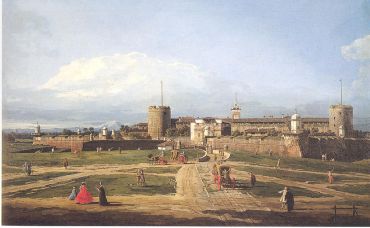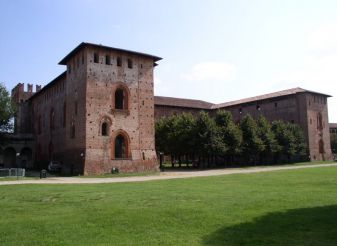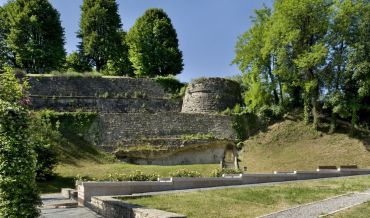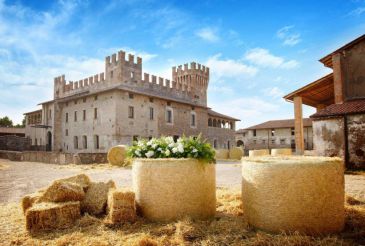Sforza Castle, Milan
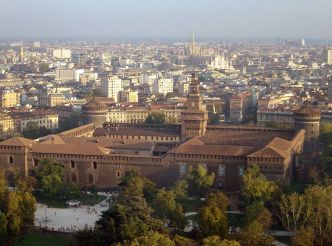
You will need more than one day to get around and get a good look at the Castello Sforzesco, located in Milan. This huge ancient building holds not only a long and troubled history, but also a lot of museums devoted to a wide variety of topics: from mysteries of ancient Egypt and the evolution of the inhabitants of this area to the decorative art of Italy and the collection of printed publications. Each visitor will find the exhibition to their taste and will definitely feel the beautiful and incredibly rich world of this country.
History of Sforza Castle
The history of Sforza Castle dates back to the 14th century. Lord of the western region of Milan – Galeazzo II Visconti – built a fortress here between 1360 and 1370. Then it consisted of two parts, separated by a so-called dead moat-walls, and was the residence of the Visconti family. After the proclamation of the Ambrosian Republic, the building was badly damaged and Francesco Sforza (in Italian Sforzesco) took up his restoration. With the support of military engineers, the fortress was modified and strengthened in accordance with the needs of the time. The work ended with the eldest son of Sforza, who moved to the palace with his wife. In the time of French rule, the castle was used as an ammunition depot and, as a result of the explosion, the tower of Filaret was destroyed. In the second half of the 16th century a whole garrison was located on the territory of the fortress. There were a hospital, a pharmacy, shops, a bakery, two churches here.
In 1706, the Austrian commander Eugene of Savoy conquered Milan on behalf of Emperor Joseph I of Habsburg. The only evidence of that time is the statue of St. John of Nepomuk, patron of the Austrian troops.
At the end of the 18th century, the fortress was in the power of the Napoleonic army. A restructuring was planned to ensure that the castle functioned as the best possible residence of the new government. However, after the withdrawal of Napoleon and the return of the Austrians, the building was again used for barracks. From 18 to 22 March 1848 the castle became a prison for the people of Milan arrested by the Austrians. When the Austrian troops were withdrawn, the fortress was plundered by the inhabitants of Milan.
Luca Beltrami was the head of the restoration of the castle, which began in 1892. Little by little the building was being reconstructed, towers and frescoes were being renewed. And as a result of numerous works, it became as we can see it today.
Museums of Castello Sforzesco
Sforza Castle is incredibly rich in museums and exhibitions for every taste and interest. Here you can find:
- Museum of Ancient Art (Museo d'Arte Antica). There are collections of statues, sculptures, tombstones, dishes here. Some of the exhibits were created in the 5th century, and most of them in Milan itself.
- Hall of the axis (Sala delle Asse) is one of the most famous rooms of the castle. The fact that the frescoes on the walls of this room belongs to Leonardo da Vinci himself brought it popularity.
- Museum of Pietà Rondanini (Museo Pietà Rondanini) is a sculptural composition depicting the Mary's mourning of her dead son. It belongs to the hand of Michelangelo.
- Gallery (Pinacoteca). Works of art from the middle of the 15th century to the Neoclassic era are presented here. In addition to the art collection, you can see fragments of murals or frescoes, wooden reliefs, marble statues, busts, medals.
- Museum of Furniture and Wooden Sculptures (Museo dei Mobili e delle Sculture Lignee). Visitors will be able to see how furniture has changed during 6 centuries, since the 15th century. The museum has 4 sections. You can see beautiful wedding chests and wooden sculptures in the section which is dedicated to the court and the church. In the so-called room of the scientist, the guests will see a variety of materials: precious wood, ivory, precious stones. Baroque and Rococo are represented in large halls intended for secular receptions. The section "Masters of Style" exhibits unusual furniture from the period of Giuseppe Maggiolini and his followers.
- Museum of Decorative Art (Museo delle Arti Decorative) presents tapestries, weapons, bone and bronze articles, porcelain, leather, wrought iron, gold, glass. Exhibits date from the early Christian era to our time.
- Museum of Musical Instruments (Museo degli Strumenti Musicali) is a collection of musical instruments, as well as devices for their manufacture. Here you can get acquainted with plucked, stringed, wind instruments. Ethnographic musical component is presented.
- Archaeological Museum, Department of Prehistory and Protohistory (Museo Archeologico – Sezione Preistoria e Protostoria). The exhibition shows the evolution of the area from the Neolithic period to Roman colonization.
- Archaeological Museum, Department of Egypt (Museo Archeologico – Sezione Egizia) includes numerous finds made during excavation in Egypt. Among other things, you can get acquainted with bronze figurines, mummies of animals, amulets, vases, sarcophagi, funeral equipment.
- The collection of printed publications "Achille Bertarelli" (Raccolta delle Stampe "Achille Bertarelli") is a collection of a huge number of graphic works, prints, including greeting cards, business cards, games, maps, calendars, letters, flags.
- The drawing room (Gabinetto dei Disegni) stores about 28,000 graphic works of the 14-20 centuries. It includes design projects of Italian and foreign schools, made in different techniques and devoted to different topics.
- Photo Archive (Archivio Fotografico) is a collection of 850,000 photographs taken from 1840 to today, represents all photography techniques that existed in the 19th and 20th centuries.
- The Civil Historical Archive and the Trivulziana Library (Archivio Storico Civico e Biblioteca Trivulziana) is a large collection of Italian and foreign periodicals, manuscripts, documents.
- The Art Library (Biblioteca d'Arte) includes more than 100 000 volumes dedicated to art, museology, graphics, architecture, design, fashion, visual arts.
- Archaeological and numismatic library (Biblioteca Archeologica e Numismatica) stores a wide collection of catalogs of auctions, correspondence, lists of numismatic sales, protocols.
- Center for Advanced Studies in Visual Arts (Casva (Centro di Alti Studi sulle Arti Visive)) holds professional and personal archives of famous architects, designers, artists.
- The Vinciana Collection (Ente Raccolta Vinciana) is devoted to the work of Leonardo to Vinci. The facsimile editions of his manuscripts, rare photographs of the works are represented here.
- The cabinet of numismatics and medallic art (Gabinetto Numismatico e Medagliere) is a collection of coins and medals, consisting of 280,000 copies.
How to get there
To reach the Sforza Castle in Milan, you can take:
- Metro along the line M1, stop Cadorna FN or Cairoli; M2, stop Cadorna FN or Lanza.
- Buses № 50, 57 (stop Cairoli) 58, 61, 94 (Cadorna).
- Tram № 1 or 4 (stop Cairoli); 2, 12 or 14 (Lanza).
Opening hours: Sforza Castle museums are open for visits from Tuesday to Sunday from 9:00 to 17:30. The castle itself is open from 7:00 to 19:30.
The entrance fee for museums is 10 euros. One ticket allows you to visit all of the museums of the fortress. The castle itself can be visited free of charge.



